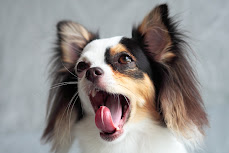Chihuahuas:
Patellar Luxation:
Also known as "slipped stifles," this is a common problem in small dogs. It is caused when the patella, which has three parts-the femur (thigh bone), patella (knee cap), and tibia (calf)-is not properly lined up. This causes lameness in the leg or an abnormal gait, sort of like a skip or a hop. It is a condition that is present at birth although the actual misalignment or luxation does not always occur until much later. The rubbing caused by patellar luxation can lead to arthritis, a degenerative joint disease. There are four grades of patellar luxation, ranging from grade I, an occasional luxation causing temporary lameness in the joint, to grade IV, in which the turning of the tibia is severe and the patella cannot be realigned manually. This gives the dog a bowlegged appearance. Severe grades of patellar luxation may require surgical repair.
Hypoglycemia:
Hypoglycemia, or low blood sugar, is a possible problem with all toy breed puppies. [Note: I have left this as toy breed here. There is a difference between toy size and small dogs-the difference, say, between Chihuahuas and yorkies and beagles and mini dachshunds.] Hypoglycemia is easily treatable in the early stages but can be fatal if not treated. It is important that breeders and owners of toy breed puppies recognize the signs and symptoms because this condition can sometimes be misdiagnosed as viral hepatitis or encephalitis by veterinarians. A puppy with hypoglycemia will slow down and become listless, followed by trembling or shivering. Place some honey under his tongue and get him to the vet immediately. If the situation is allowed to continue, he'll eventually collapse, go into convulsions, fall into a coma, and die. Any time your Chihuahua is limp, with grayish-blue gums and tongue, it's an emergency. Hypoglycemia occurs in toy puppies when they don't have the fat reserves to supply adequate glucose in times of stress or when they don't eat regularly.
Heart Murmurs:
Heart murmurs are caused by adisturbance in the blood flow through the chambers of the heart. They're an indicator that there may be a disease or condition of the heart that will need to be monitored and treated. Heart murmurs are graded on their loudness, with one being very soft and five being very loud. If disease is evident, as diagnosed through x-rays and an echocardiogram, the dog may require medication, a special diet, and a reduction in the amount of exercise he gets.
Pulmonic Stenosis:
This congenital heart disease occurs when blood doesn't flow properly through the heart because the pulmonic valve is malformed, causing an obstruction. This means the heart must work harder and can become enlarged, leading to heart failure. Treatment depends on the severity of the disease. In mild cases, there's little or no obstruction and no treatment is necessary. If the dog is severely affected by the disease, surgery is recommended, but the procedure differs depending on the location of the blockage.
Collapsed Trachea: It is not completely understood how this occurs, but the rapid inhalation of air causes the trachea to flatten and makes it difficult for air to enter the lungs, much like a soda straw being drawn on too vigorously. This condition may be inherited; it occurs in certain breeds, and dogs with it show an abnormality in the chemical makeup of their tracheal rings in which the rings lose their stiffness and become unable to retain their circular shape.
Hydrocephalus:
Cerebrospinal fluid (CSF) can accumulate in the brain because of a congenital defect, obstruction, or the result of trauma during birth, placing pressure on the brain. The head looks swollen or enlarged, but the diagnosis can be confirmed with an ultrasound if necessary. There's no cure for hydrocephalus, although in mild cases steroids can help reduce fluid pressure. A shunt can also be used to divert fluid from the brain to the abdomen. Puppies with severe cases usually die before they're four months old, which is a good reason to delay purchasing a Chihuahua until that age.
Open Fontanel:
Chihuahuas are born with a soft spot on the top of their head. Usually the soft spot closes, much like a baby's will, but sometimes one will not close fully. Treat these dogs gingerly. An accidental blow to the head can kill them.
Shivering:
Shivering is a common occurrence in Chihuahuas. The mechanics of why they shiver or tremble is unclear but it usually occurs when the dog is excited, stressed, or cold.
Shih Tzu:
Allergies:
Are a common ailment in Shih Tzu. There are three main types: food allergies, which are treated by eliminating certain foods from the dog's diet; contact allergies, which are caused by a reaction to a topical substance such as bedding, flea powders, dog shampoos, or other chemicals; and inhalant allergies, which are caused by airborne allergens such as pollen, dust, or mildew. Treatment may include dietary restrictions, medications, and environmental changes.
Canine hip dysplasia:
An abnormal formation of the hip socket that can cause pain and lameness.
Patellar luxation, which means dislocation (luxation) of the kneecap (patella). The knee joint (often of a hind leg) slides in and out of place, causing pain. This can be crippling.
Juvenile renal dysplasia (JRD):
Is a genetic defect of the kidneys seen in young dogs. The dog is excessively thirsty and urinates frequently. He loses weight, vomits, and lacks vigor. Currently, there is only one definitive test for the disease that can be performed on breeding dogs--a wide-wedge biopsy of the kidney, which is very invasive and carries a lot of risk. There have been swab tests developed by geneticists, but, to this date, none of them appear to be 100 percent reliable.
Bladder stones and bladder infections can be caused by many factors, such as excessive protein, magnesium, and phosphorus in the diet, or long periods of time between urination. Bladder infections can be caused by bacterial or viral infections. If your Shih Tzu needs to urinate frequently, has bloody urine, seems to have difficulty urinating, or suffers a loss of appetite, take him to the vet for a checkup.
Eye problems:
Are not uncommon among Shih Tzus because their large eyes bulge. Disorders include keratitis, an inflammation of the cornea that can lead to a corneal ulcer and blindness; proptosis, when the eyeball is dislodged from the eye socket and the eyelids clamp behind the eyeball; distichiasis, an abnormal growth of eyelashes on the margin of the eye, resulting in the eyelashes rubbing against the eye; ectopia cilia, a condition similar to distichiasis; progressive retinal atrophy, a degenerative disease of the retinal visual cells that progresses to blindness; and dry eye (keratoconjunctivitis sicca), a dryness of the cornea and the conjunctiva. Contact your vet right away if you notice any redness, irritation, or excessive tearing.
Ear infections:
strike the Shih Tzu because his drop ears create a dark, warm ear canal--a perfect environment for infection. Check and clean the ears weekly to avoid problems.
Teeth problems:
Retained baby teeth and tooth and gum problems are not unusual because the Shih Tzu's baby teeth may remain intact when the permanent teeth emerge. Sometimes it is necessary for the veterinarian to extract the baby teeth. Because of the Shih Tzu's undershot jaw, he also can have missing or misaligned teeth. It's important to brush puppy teeth regularly and report dental problems, such as bad breath and loose teeth, to your veterinarian.
Umbilical hernias:
Are common among Shih Tzus. Quite often, these are caused by delayed closure of the abdominal midline. If the hernia is small, it may close as the puppy matures. Sometimes surgery is necessary to correct it, usually while the puppy is being spayed or neutered.
A portosystemic liver:
Shunt is a congenital abnormality in which blood vessels allow blood to bypass the liver. As a result, the blood is not cleansed by the liver as it should be. Surgery is usually the best treatment.
Snuffles:
Mayplague the Shih Tzu because teething tends to be difficult. At about four months, the gums swell; since the gums are directly under those pushed-in noses, there isn't a lot of room. Puppies may snort, snuffle, snore loudly, or wheeze during this time, and may even have a clear nasal drainage.
Reverse sneezing:
occurs when the dog is overly excited, gulps his food too fast, or allergens are present. Nasal secretions drop onto the soft palate, causing it to close over the windpipe. The dog makes a wheezing sound and may become alarmed. Talk soothingly to him and try to get him to relax to shorten the episode. Some say that pinching the nostrils closed, so the dog is forced to breathe through its mouth, is the quickest way to stop the reverse sneezing.
The end of an era...
2 years ago






No comments:
Post a Comment